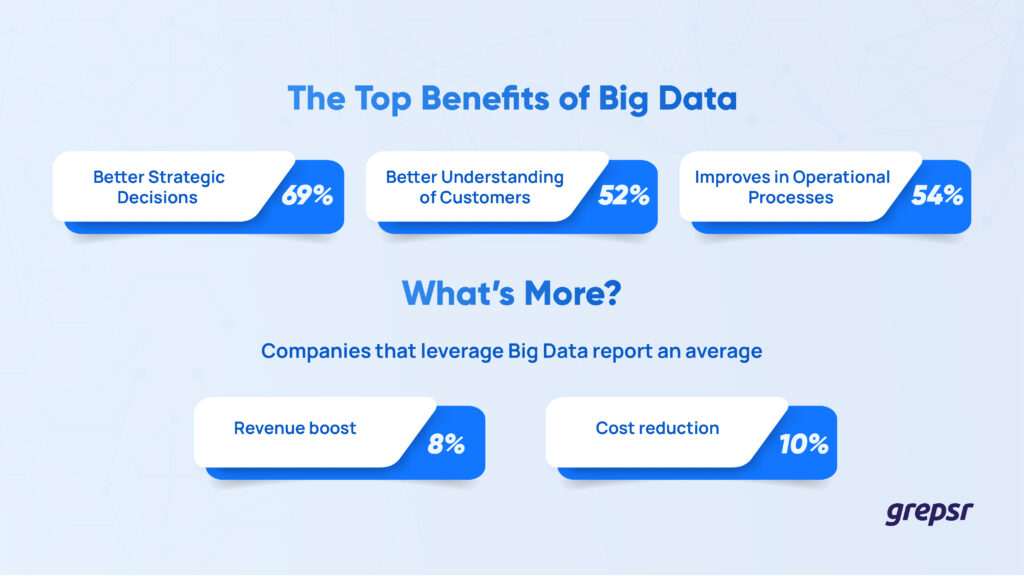
Big Data — data so big we invented new words like zettabytes to measure it.
Over 5 billion of us use the internet daily — and like muddy car tires, we leave tracks everywhere — our digital footprint. Whether it’s a quick Google search, posting on Instagram, or how long we spend watching Parks and Recreation on Netflix; all of this information is tracked, stored, and analyzed.
Think of Big Data as a snowball rolling down a hill. In 1999, the term referred to just one gigabyte. Today, that snowball is the size of a mountain, or even a continent. You could stack all the data created in just one day on top of each other and reach the moon. Twice.
But what does the industry look like from a numbers perspective? In this blog, we’ll cover 31 amazing statistics about Big Data from industry-specific facts to market projections and trends.
Buckle in, we’re going to the moon!
Big Data Growth Statistics 2024
- By 2025, the world will produce slightly more than 180 zettabytes of data. (Statista)
- The global Big Data industry is projected to surge to $401.2 billion by 2028. (Markets and Markets)
- How many organizations are investing in Big Data and AI? A whopping 97.2%. (New Vantage)
- The major challenge facing businesses today is collecting high-quality, real-time data at scale. If you’re ready to make the shift from reactive to proactive data, we can help you with our automated data extraction services!
- Big Data in business intelligence applications will reach $63.5 billion by 2028. (Global Big Data Markets Analysis Report)
- In 2025, 463 ZB of data will be created daily, and the Big Data market will be worth $229.4 billion. (Finances Online)
Now, let’s zoom in just a little — narrow our focus to the everyday.
What Happens In An Internet Minute?
What happens in sixty seconds on the internet every day? How much data do we generate?
Thanks to our friends at Domo who published their 11th report on Data Never Sleeps, we have an eagle’s eye view of what’s happening in just sixty seconds on the internet:

- Emails sent: 241 million.
(That’s six zeroes, in case you were wondering.)
- LinkedIn resumes submitted: 6,060.
(Thanks to Easy Apply, eh?)
- WhatsApp messages sent: 41.6 million.
- Number of times fans stream a Taylor Swift song: 69,400.
You’re probably thinking, “Sure, these statistics about Big Data are staggering, but what do they actually mean for me and my business?”
Each email reveals professional communication preferences. Resumes highlight career priorities. A massive volume of messages indicates the dominance of real-time digital interactions. There’s even a window into viral pop culture moments in music streams.
All of this is to say that leveraging Big Data is your competitive advantage to provide better service to your customers.

Statistics About Big Data and Improved Customer Experience
You can boost your profits by 25% by increasing your customer retention by just 5%. No, really.
In a world of anonymized numbers, customers are swayed by how well their favorite brands know them and can respond with timely and relevant content.
Enter, personalized customer journeys.
Enter, real-time customer data.
Enter, Grepsr.
- Refined customer analytics increase customer loyalty and retention by 58%.
- When enterprises adopt and integrate customer analytics into their operations, 44% gain new customers and increase revenue.
- Think of real-time data as powering bespoke designs for your customers in a market full of off-the-rack choices. They get the personalized experience, you get their repeat business. Win-win.
- Analyzing real-time customer data delivers the greatest business value in two areas: improving customer experiences (85%) and driving customer retention and loyalty (58%).
- Netflix saves $1 billion a year by using Big Data to retain customers. (CMS Wire)
- To put it into perspective, that’s the same as giving every Netflix subscriber a free month of streaming.
Big Data’s Big Impact on Business Performance
Can Big Data improve business performance? According to these Big Data statistics, the answer is a heck yes:
- Businesses that invest in data and analytics report a profitability or performance increase of at least 11%. (KPMG Global Tech Report 2023)
- The top benefits of Big Data are better strategic decisions (69%), improvements in operational processes (54%), and a better understanding of customers (52%). The organizations that can quantify their gains from analyzing Big Data report an average 8% revenue boost and 10% cost reduction. (BARC)

- These statistics about Big Data are our favorites. Why? Because these quantifiable metrics prove just how valuable collecting data is — from the right sources, and with the right technologies. This is where we come in.
- 54% of organizations with advanced data and analytics maturity have increased their revenue, and another 44% have achieved a competitive advantage. (WNS)
The question then becomes: how do these Big Data statistics translate into real-world efficiencies?
The Big Data Way to Streamline Operations
- UPS optimized routes using Big Data and machine learning, reducing fuel consumption by 10 million gallons and emissions by 100,000 metric tons. (Forbes)
- That’s the equivalent of taking 21,000 cars off the road each year. A big win for UPS’s bottom line perfectly aligned with their sustainability initiatives.
- How many pizzas does Domino’s deliver in a day? Thanks to Big Data — three million. (Restaurant Business Magazine)
- That’s a lot of pizza — enough to make Italy blush. Domino’s online orders accounted for 70% of sales in the US, and delivery times averaged less than 30 minutes.
Next up: how Big Data is exploding in the retail, healthcare, finance, and real estate industries.
Industry-Specific Statistics About Big Data
Big Data in Retail:

- Global revenue at Target increased by 15% within a year after implementing Big Data-driven price optimization. (Turing)
- Walmart’s implementation of data-driven demand forecasting resulted in a significant reduction in overstocked inventory and stockouts by 30%. (Grepsr)
- This example is proof of how retailers can improve their inventory management and reduce waste by using Big Data. Looking to make smart, data-driven decisions? Grepsr’s managed data extraction and web scraping services can help your business gather the proactive data you need to make informed business choices.
- Similarly, using Big Data, Apple has seen a 25% increase in customer satisfaction ratings across its various devices over the last year. (Digital Information World)
Big Data in Healthcare:

- The market size for Big Data in healthcare is estimated to grow to USD 540 billion by 2035. (Roots Analysis)
- Think, improved patient outcomes, more accurate health forecasts, optimized clinical trials, and better remote monitoring.
In fact…
- Big Data at Corewell Health has decreased readmissions by 200 patients and saved $5 million in costs. (Spectrum Health)
Big Data in Finance:

- In 2026, the market for Big Data analytics in FinTech is projected to grow to $141.5 billion. (Zipdo)
- Big Data has helped American Express reduce fraudulent transactions by 60%. (Harvard School of Business)
- When you can analyze massive datasets in real time, consumer behavior and transactional trends become easier to track, monitor, and analyze. The result? Reduced fraud, better process optimization, and enhanced security.
- Meanwhile, advanced analytics and Big Data can generate a $250 billion annual value for banks. (Zipdo)
Big Data in Real Estate:
- Among respondents, 30% think automation will have the biggest impact on real estate in the short term, while 27% think Big Data and data analytics will. (KPMG)
- Imagine being able to sell more houses by painting your bathroom walls a particular shade of blue. That’s the power of Big Data in real estate.
- Forecasts from 2020 to 2027 show that predictive analytics adoption in real estate will increase at a rate of 23.8%. (Times Tech)
We promised you the moon. We’re almost there…
Statistics About Big Data’s Future
- By 2028, the global Big Data analytics market is forecast to reach $549.73 billion. (Fortune Business Insights)
- That’s more than the combined GDP of Norway, Ireland, and Portugal! (We did the math.)
- Approximately 30% of the ‘Global Datasphere’ will be real-time data by 2025, created by connected users who will have a digital interaction about every 18 seconds. (IDC)
- The number of consumers interacting with data is growing — by 2025, it will be 6 billion — or 75% of the world’s population. (Seagate)
In (Big) Data We Trust
The statistics about Big Data tell a compelling story, don’t they? From healthcare to retail to finance, the numbers don’t lie.
However, with Big Data, comes big responsibility. So, wherever you are on your data journey, you need secure, real-time business intelligence that helps you make data-driven decisions and boosts operational efficiency.
The future belongs to those who can ride the Big Data wave — and with us, you never have to worry about getting left in the dust. Get in touch today to discuss your business’s needs!












































































































